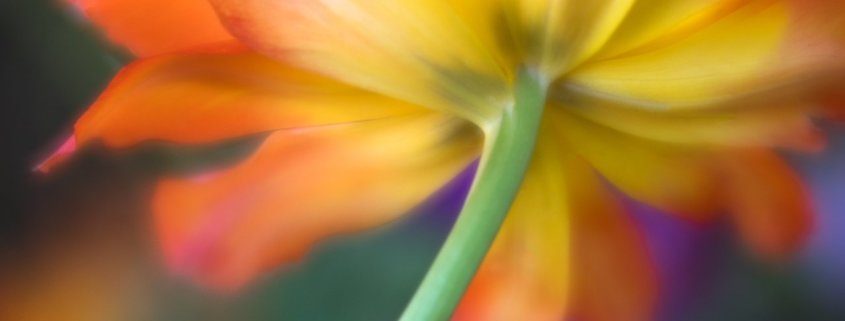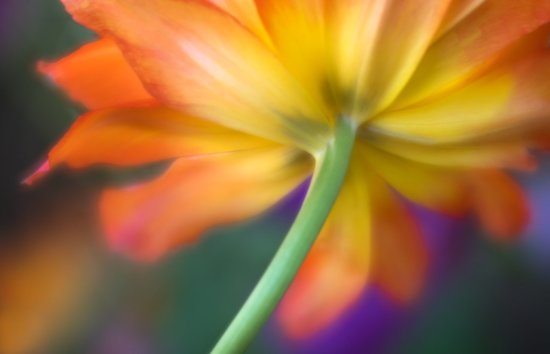Flower Photography Tips for Capturing Stunning Photos
Flowers are a popular subject for photography, full of color, texture, patterns and personality. This time of year many of us begin to count the days until spring arrives. As a nature photographer specializing in flower photography, I look forward to the time when the earth comes to life again and the spring flowers appear. Although my preference is to photograph flowers outdoors, I can still enjoy flower photography in the winter months. During the winter I find plentiful subjects in greenhouses, conservatories and by bringing flowers home from my neighborhood florist to photograph in natural window light.
My hope is that you can practice some of these skills indoors before heading outdoors when spring finally arrives, or perhaps you are one of the lucky ones who live in a warmer climate and enjoy flower photography outdoors year-round.
Tip #1: Slow Down & Learn to See
You have probably heard this mantra over and over, but once I started practicing this, my photography changed dramatically. It sounds so simple, but I find few people actually practice it. Leave your camera in your backpack initially, put your phone away and walk slowly, observing all that is around you. I find that being in nature naturally relaxes me and puts me in more contemplative state of mind. The distractions of the day exit, my mind clears and my senses are more aware.
I think most people would agree that being in nature is a kind of therapy. Train your eye to notice details, look for interesting lines, sensuous curves, a unique curl of a petal or leaf. Learn to see your subjects more abstractly, in terms of lines, color, texture, patterns and mood. Slowing down will sharpen your visual skills and help you find more interesting and unique subjects. You will create work that is more impactful, work that evokes feelings and perhaps even stories. For me, the process of finding and capturing images is equally important as the end product. By focusing on the process and enjoying the process, we will more likely convey those feelings to others.
Tip #2: Learn to Work with Light
Light is one of the most important elements in all genres of photography and key to beautiful flower portraits. Just like we need to slow down and learn to see to find interesting subjects, we also need to learn to recognize the quality and the direction of light best suited for photographing flowers. Generally speaking, you want to photograph flowers in soft, diffuse light. Although there are a few exceptions when using strong sunlight in backlighting can be beautiful, you want to avoid the harsh highlights and deep shadows that strong light produces.
I like to shoot in what I call bright overcast, a layer of clouds acts to diffuse the sun but adds enough light to bring the flowers to life and add sculptural details. Early morning when the sun is low in the sky is the perfect time to get this more subdued light and it also adds another important element, side light. Side light will act to bring out details and texture in your flowers and make them appear more three-dimensional. Side light will effectively do all the work for you, very little post-processing is needed to bring the flower to life. You can get this same beautiful light in the late afternoon or early evening. It is always important to carry a diffuser and a reflector when shooting in stronger light. I carry a small 12” diffuser and a 22” 5-in-1 diffuser with reflective surfaces. A reflector will help guide light into darker recesses or parts of the flower you want to draw the eye to.
Tip #3: Learn to Work Your Flowers
Once you find an interesting subject, work that subject to its fullest. I often see photographers in garden settings walk up to the first flower they see, take a shot or two and move on. It is not unusual for me to stay with the same flower for over an hour, taking hundreds of images from every angle and composition I can come up with. A good starting point is to ask yourself what drew you to the flower, how does it make you feel? Then, think about how you can compose to bring that element or feelings to others’ eyes. Perhaps it is a an interesting curl of a dahlia petal, a gentle curve of a leaf or the curve of a stem that makes the flower appear to be dancing.
I often start by composing with the rule of thirds in mind. We should all understand this rule and practice it. There is a reason it has been in the art world for hundreds of years – it is an effective way to lead the eye. The rule of thirds is not the only way to compose flowers; we can break this rule when there is a compelling reason to do so. For example, I will often center compose or move the center of the flower to the middle of the frame but slightly offset it. This is an effective composition when emphasizing pattern and symmetry in a flower. Shoot up under the flower, or even behind the flower. Sometimes the backs of flowers are much more interesting than the fronts. By experimenting and working your subject, you will come up with new ideas and perhaps have some aha moments. Many times I have ended up with a very different composition than I originally imagined by working my subject.
Tip #4: Experiment with Aperture & DOF
If you are new to macro or flower photography, the best way to advance your learning and to understand what your lenses are capable of is to experiment with aperture. Depth of field is one of the most important elements in learning macro photography. Depth of field is determined by your aperture, how close you are to your subject, how far away your background is, and what lens you are using. There is no cookbook method to teach what aperture is going to work best to bring your vision to life. It comes from a lot of experimentation and experience. I tell beginning macro photographers to shoot a flower in a range of apertures and study the results.
As you do this, you might begin to see that you enjoy shooting in the lower apertures (f/2 – f/6.3) using selective focus to bring one element of the flower in focus – the edge of a petal, a ruffle of an orchid. Or, you might find you prefer having the entire flower in sharp focus. For this approach, choose a higher aperture (f/11-f/22) and try to align your camera so that it is parallel with the flower.
There is no one right way or right aperture to photograph a flower. Shoot in a way that brings you joy, that conveys the feeling you want to convey and brings your vision to life. Much of my flower photography is done with Lensbaby lenses, shooting in apertures between f/2 – f/5.6 to get the beautiful effects these lens are known for. This is a way of shooting that excites me and brings creativity to my photography.
That being said, there are times when I want to capture each and every detail of a flower and shoot in higher apertures to achieve that. Again, by asking yourself those important questions of what drew you to the flower, how does it make you feel, and what do you want to convey will help you determine aperture. Experiment!
Tip #5: Pay Attention to Your Background
Good, clean backgrounds are essential to a beautiful flower portrait. A messy, distracting background can ruin an image and pull the eye away from the main subject. New photographers are often so entranced with capturing the flower itself, they forget to pay attention to the background. Many people find this aspect of photographing flowers the most challenging. Here are a few tips for getting it right in camera so you don’t have to do a lot of post processing magic to correct a bad background.
- Learn to position yourself. Before you set up your shot or put your camera on a tripod, look through your lens and move around. Watch what happens to your background. By moving just a fraction of an inch you can completely change a background, eliminate a bright spot of light or distracting elements. Choose flowers that have darker foliage and cleaner backgrounds or backgrounds that are in a distance.

“Opening Dahlia,” 100mm macro photography lens at f/5.6 – Hedge in a distance provides clean background
- Use aperture to control your background. This can require a bit of experimentation and knowledge of your lens. It’s a matter of choosing just the right aperture that will get the important elements in your flower in focus and keep your background a creamy blur – the lower your aperture, the more blur you will have in your background. Practice bracketing your apertures and then examine them on your computer screen.
- Choose a lens that will help you create a beautiful background. This is one of many reasons I love shooting with Lensbaby, in particular the Velvet 56mm and the Velvet 85mm. The art effect built into the lenses create beautiful, effortless backgrounds. The same concept applies to using a longer focal length macro lens such as a 180mm. I often reach for my 180mm to create beautiful backgrounds that might be harder to control with my 100mm macro.
- Lastly, simply move in and eliminate your background altogether. As a macro photographer I enjoy working very close to my subjects to bring the eye to the tiny details of nature. I will move in close and eliminate all background from the image. By moving in, I am helping to direct the eye to what I want the viewer to see and this can create a very impactful image.
Tip #6: Don’t be afraid to use a Tripod… or Not
That is the question! This may seem like a silly question, as many photographers feel it is essential to be on a tripod to produce good macro images. Many people are surprised to learn that I do a large percentage of my work hand-held. I am blessed with a steady hand and I am often working in the lower apertures where plenty of light enters my lens, which means high shutter speeds and less possibility of camera shake. I love the freedom of hand-holding so that I can easily get into difficult positions and angles. However, I do not recommend hand-holding to everyone, however.
Certainly if I am working in lower light situations or in higher apertures, I always use my tripod. A good, sturdy tripod is absolutely essential to macro flower photography, whether you use it all the time or part of the time. I recommend that all beginning photographers work on a tripod. It slows you down, helps you compose more carefully and thoughtfully, and allows you to experiment with aperture easily. When using a tripod, use a shutter release cable and Live View to manually focus. Zoom in through Live View and focus on the area that is most important in your composition. Once you are completely comfortable with using your camera and lenses, try hand-holding to see if it works for you. As a rule of thumb, you should use a minimum shutter speed equal to the focal length of your lens. For example, with a 100 mm lens, use a shutter speed of at least 1/100th. Having a lens with image stabilization will help, as well.
I hope these tips will inspire you to get out and try some flower photography. Flowers are readily available and beautiful, joyful subjects to photograph. I look forward to sharing lots of other ideas with you in future posts.

















